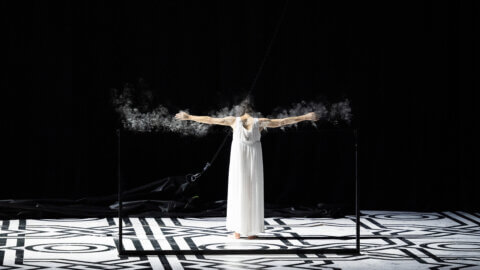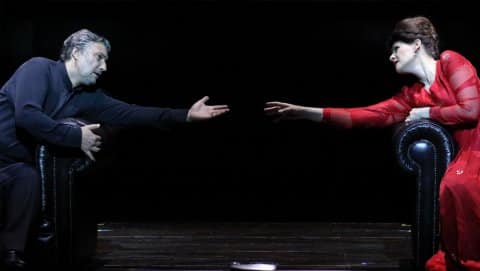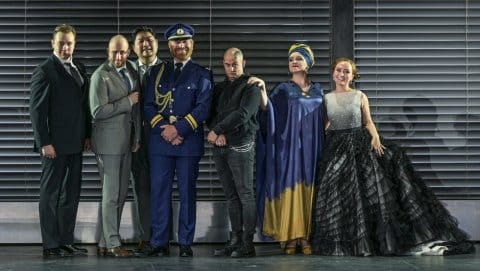ALCINA, NORMA OG PLATÉE • STUTTGART OPERA
★★★★☆☆
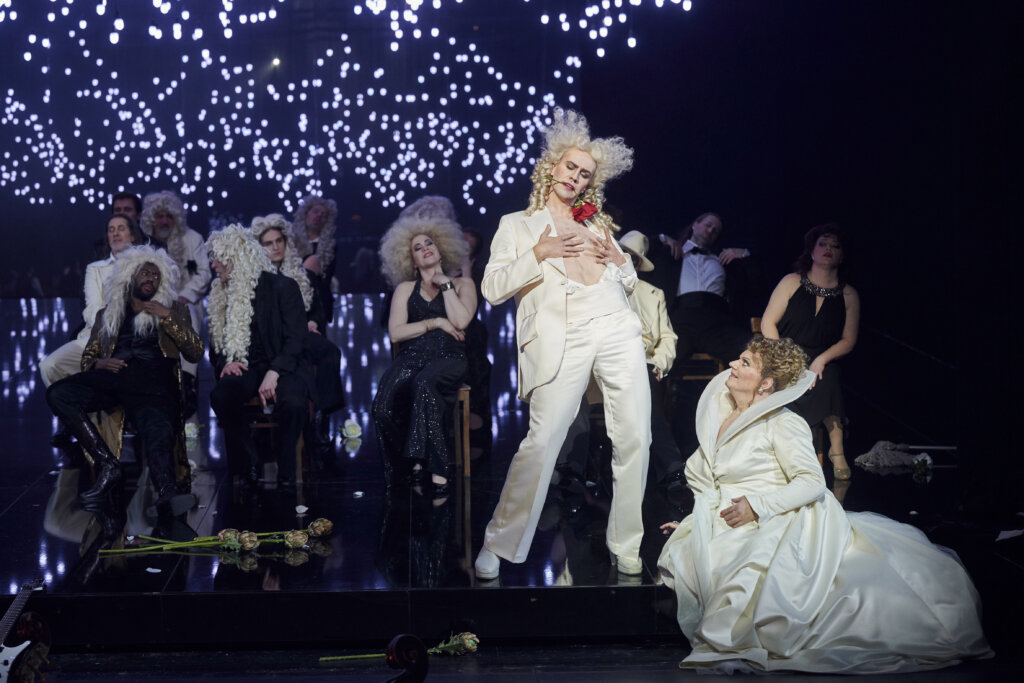
Photo: Martin Sigmund
REVIEW ALCINA, NORMA AND PLATÉE: MIXED OPERA-CANDY IN STUTTGART
Staatsoper Stuttgart is one of Europe’s leading opera houses, and one of the venues to keep an eye on as an opera fan.
With a rich repertoire, a bold profile and a strong ensemble, this southern German institution in Baden Württemberg’s capital 240 km from Munich has placed itself well ahead of the pack among strong German opera houses.
16,000 regular subscribers and 230,000 annual visitors testify to the class of a city with apopulation of 600.000. Three art forms, opera, drama and ballet, are organized as autonomous entities that work together to ensure Stuttgart’s cultural and cosmopolitan profile. It’s going damn well.
Det Sku’ Du Se/Got To See This has visited Stuttgart to see Handel’s Baroque masterpiece Alcina, Bellini’s bel canto hit Norma – and an unashamedly entertaining version of Rameau’s Rococo gem Platée.
The result was a bag of mixed opera candy which, despite a bottom scratch, together weighed in at 4 stars.
Beautifully situated by the Castle Park, the opera house is a little reminiscent of the Semperoper in Dresden, but surprises on the inside with its lack of the usual over-the-top vulgar baroque, drowning the audience in red velvet and golden crumbs. The 1400-seat auditorium is done in dark wood, silver and earth-toned wallpaper.
The foyer on the first floor juts out in nightclub-style bar and lounge design with direct access to the viewing terrace, where a well-dressed, surprisingly young crowd feasts on canapés, pretzels and sparkling Aperol Spritz flashing in the sun.
★★☆☆☆☆ ALCINA

Photo: Martin Sigmund
Alcina a revival of Jossi Wieler and Sergio Morabito’s original 1998 staging.
Why?
The orchestra and singers are excellent, but the staging is a load of scruffy nonsense that has received deserved critical plaudits.
‘A goofy production gone astray with neither direction nor meaning – a tiresome cliché meant to be artzy, daring and different’, as it has been described, among other things.
Baroque operas tend to play for 3-4 hours. I hope it does not seem too uncultivated to think that such a long time in the seat makes great demands – on the qualities of the singers and the orchestra – and not least on the stage performance.
This is known to star directors such as Barrie Kosky and Stefan Herheim, who, with spectacular versions of Agrippina in Munich/Hamburg and Xerxes in Berlin respectively, have succeeded greatly in bringing 300-year-old Händel operas to life.
A mission that in no way succeeds in this case.
The set consists of a battered rococo suite in what used to be the magnificent palace of the seductive Queen Alcina.
Aside from a pile of assorted bric-a-brac junk in one corner – old shoes – a fall horn, a broken chair and more – the interior consists of a giant gold frame that opens a hole into the backstage, where things can play out as if they were a mirror image of what’s going on up front.
The effect isn’t too bad and makes for watchable action, but we just stay there, and for three hours it’s too little. Why don’t they just call Karin Betz!
Alcina is opera seria, a classic epic turned romantic comedy. Selfishness reigns, but is ultimately conquered by love.
I have read the synopsis three times on various net lexicons and still cannot reproduce the plot succinctly and clearly. This ‘updated’ interpretation has even severed so many of the ties to the original that unrecognizability has set in.
In broad strokes, it’s about this lowly Queen Alcina who lures men to her enchanted island, violates them and, when she’s tired of them, turns them into rocks or wild animals.
A group of newcomers sets in motion a completely unmanageable comedy of confusion and disguise that surges back and forth in no fewer than 44 arias, a myriad of choruses and a large number of recitatives.
The confusion is not lessened by the fact that many of the normal male roles here are played by women, turning Alcina’s erotic big-time into a madcap, galloping #Me Too, where she frames anything on stage that has a pulse. The vibrations of love, which are the focal point of the show, are tingling everywhere and in every direction.
After a fairly short time, you get nada. Forced action and shoot-outs in due course do their best to prevent marginally interested season ticket holders from falling asleep in the process.
The singers, on the other hand, are excellent. In-demand, lyrical coloratura soprano Elena Tsallagova impresses in the title role, as does Croatian mezzo Diana Haller, who shines in the role of Ruggiero.
The Italian soprano Claudia Muschio, whom I hope to see again soon, is absolutely sublime.
In the opera’s lively hit aria ‘Tornami a vagheggiar’ she draws wild applause with her, easy-going, yet strong-sounding coloratura vocal, which together with her vivid gestures brings out the best in Handel.
The orchestra is perfectly reminiscent of Concerto Copenhagen and plays just as well. A slender, pointed sound, driven forward energetically by the committed conductor Christopher Moulds, who also treats the harpsichord himself in the recitatives.
Two stars for Alcina. And then we move on.
★★★★☆☆ NORMA
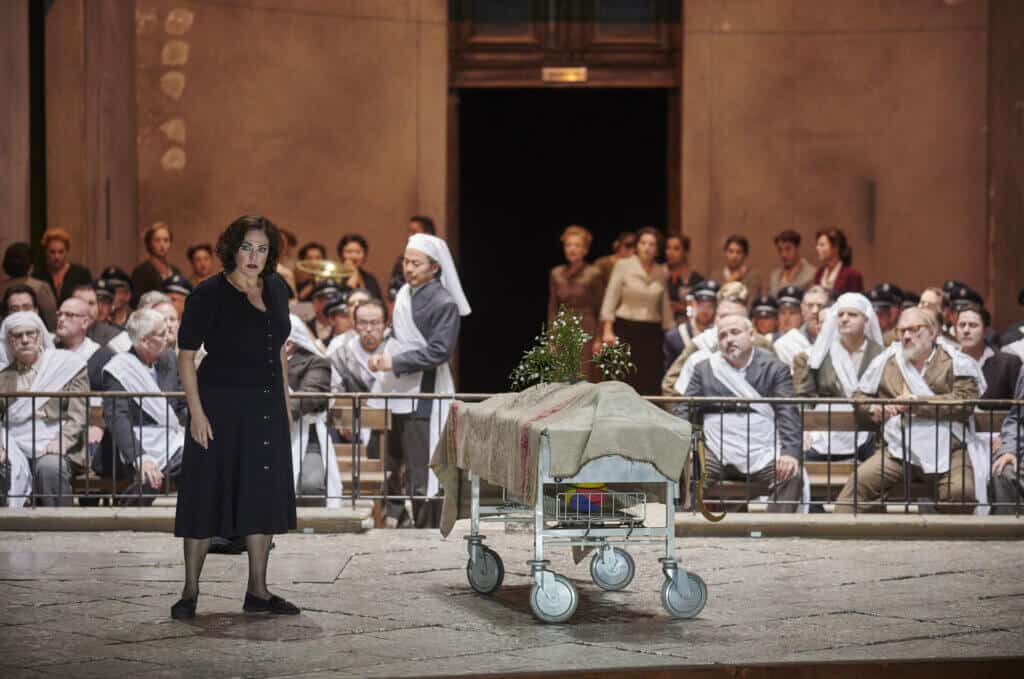
Photo: Martin Sigmund
Bellini’s operatic masterpiece Norma is the epitome of bel canto (beauty song).
From this opera comes Maria Callas’ signature aria Casta Diva (Chaste Goddess), immortalised by the divinely beautiful American/Greek star soprano. She herself died in 1977 of a heart attack in Paris.
Callas had a heavily publicized romance with shipowner and jet-setting billionaire Onassis. He later dumped her for Jackie Kennedy after the assassination of John F. Great story – check out the Callas doc on Netflix/HBO.
Norma is currently playing in Stuttgart in a production by just Jossi Wieler and Sergio Morabitos, who also have Alcina on their conscience.
The style is kind of the same, and I’m not sure I like it.
The duo seem to have a penchant for trashy stage designs that help to detract from some of the solemnity of the plot.
The question, however, is whether the grip strengthens the story or weakens it.
Both Alcina and Norma are essentially high-minded depictions of love and sacrifice.
Stripping the plot of its pathos-filled wrapping and letting it all take place in what, in Norma’s case, resembles the backyard of the local grocery store, it’s as if the play doesn’t quite know what it wants to be. Modernization, so to speak, overpaints the original authenticity and idea.
Once again we get singing performances and orchestral playing of the highest order. Already in the lead-up to the Casta Diva aria, the hit material is sensed.
In an exuberant, calm orchestration of long string harmonies and soft horns, added to Bellini’s penchant for arpeggio, the vocal line modulates effortlessly in the nearby minor and major keys with self-evident cadences, tense sevenths and lean resolutions.
This is frankly excellent music and shows operatic genius at its very best.
In particular, the accomplished Spanish soprano Yolanda Auyanets, singing the title role of the Gallic druid Norma, has the entire hall holding its breath until the second the aria ends and applause rains down on the soloist and orchestra. There you go.
Tenor Martin Muehle , who sings the Roman villain Pollione with the fat sound of a tooth-butter tenor, should be singled out.
Mezzo Diana Haller takes the cake in the role of Norma’s sidekick and leg-spinner Adalgisa – and together with Norma dominates the soundscape in several enchanting duets that make the roof lift.
The performances are high class but the staging seems momentarily problematic with several scenes where the large chorus appear unintentionally comic in silly costumes – and probably should have been spared a really silly choreographed fight towards the end.
Four stars for Norma.
★★★★★☆ PLATÉE
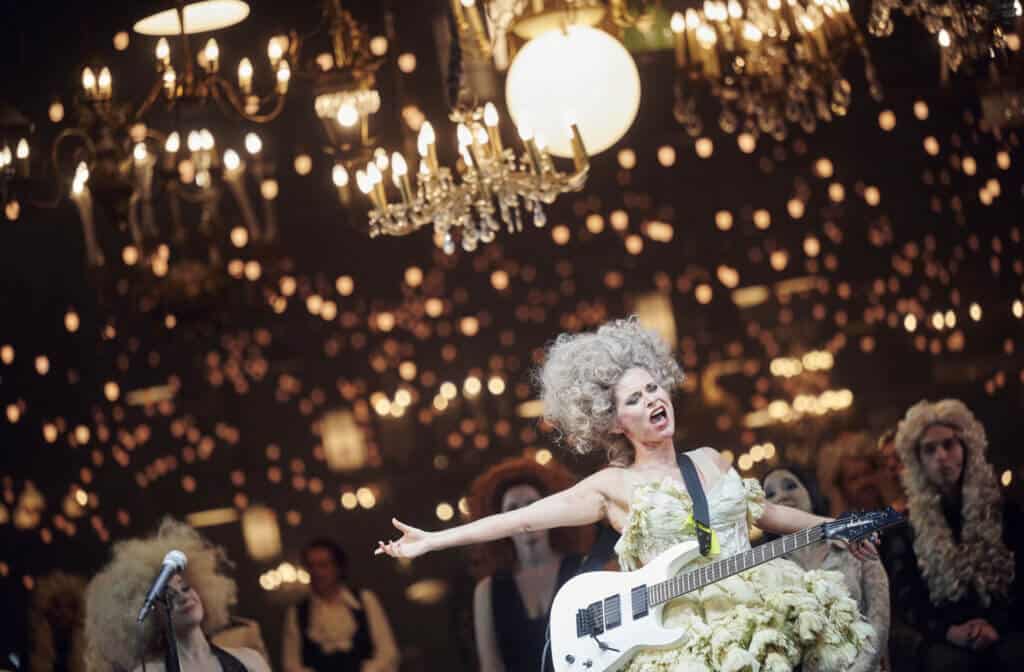
Photo: Martin Sigmund
Love is cruel. Especially when you believe in it.
A sad fact, which is the fulcrum of a terrific, fabulous firework display of sexy banter and balladry in Calixto Beito’s version of the rococo opera Plattée, which rounds off this operatic triptych in Stuttgart
Platée is a goofy romp of an opera-buffa written in the 1750s by Frenchman Rameau for a celebratory performance at the French court for the wedding of Louis IV.
It is the story of Jupiter, who is sick to death of his wife Juno’s eternal jealousy, and decides to play a trick on her to prove his loyalty.
The unfortunate victim of Jupiter’s flirtation, feigned infatuation and pompously staged just-in-time wedding is the water nymph Platée, who is tearful and has long since got used to the idea that Cupid has turned his back on her.
The finale’s revelation is all the more bitter when it turns out that Jupiter has been making a fool of her, never intending to take her for his wife.
We’re talking gross adult mockery, and it really would be tasteless if it weren’t so hilarious.
Opera historians argue that the composer was lucky to survive the premiere, as the bride Marie Therese wasn’t too pretty either, and some claimed a coincidence that could have proved fateful for the author of this coarse-grained operatic comedy.
However, the court proved to have a sense of humorous sense that day, and Rameau was subsequently rewarded with the position of court composer.
The performance is a hilarious trifle in a completely over-powered staging by the always provocative, Spanish star director Calixto Beito, who became famous, among other things, when he staged Don Giovanni in Berlin with several inventive porn actors giving it maximum gas on stage.
Queer from the inside out, this performance also oozes sex across gender and every sexual genre imaginable.
The displays range from the cute, flirtatious suggestion to the monumentally offensive, including the costuming of Jupiter himself, who for much of the opera appears with the largest, black, swinging strap-on penis I’ve seen in my life.
So when the water nymph Platée – played (of course) by a man in a glorious green sequined gown – takes firm hold of Jupiter’s heavily lifelike, one-eyed serpent and sings his rococo coloratura into the calorius, something happens to one’s normal definition of opera.
The climax of the performance is reached when a Goth-adorned ‘Follie’ fashioned by the utterly unforgettable Austrian soprano Beate Ritter topples the wedding party with booming, heavy-rock stabs from her white electric guitar, after taking the stage with a Bonjouuuur Stuutgarrrt that brings the entire good opera audience to its feet with clenched fists and devil signs in the air.
Now remember, this is a Rococo opera we’re at, with lovely 18th-century coloratura and well-played Baroque music that sparkles as beautifully as champagne under the baton of conductor Stefano Montanari.
The performance is a high-energy and wonderfully staged opera show with a constant throng of chorus and sharp soloists in outlandish costumes and imaginative settings. A frank, shameless interpretation that has come to rip the pants off the audience and succeeds in doing so.
In all the hurly-burly, the production even manages to deliver a little piece of warm poetry about the bittersweet nature of love.
I was musically spoiled and royally entertained – and give five big, twinkling palette stars to Platée.

MY STUTTGART TIPS
You don’t have to be a car freak to be enchanted by the Mercedes Benz Museum, a must-see in Stuttgart.
As well as an impressive array of top-of-the-range Mercedes, the story of Daimler Benz is told in a fresh and accessible way as you make your way down a snail-shell-like ‘lane’ in the futuristic, Guggenheim New York-inspired museum building.
A nifty juxtaposition of car designs and socio-cultural evolution from the start of the industrial adventure in 1860 to the present makes the visit worth the small excursion.
Lightning quiz: Around 1900, Daimler Benz had a dealer in Nice who insisted on developing a new and particularly powerful engine that could win racing races. The engine came, saw and won. The dealer named it after his daughter, and the name ended up embracing the entire brand. What was the daughter’s name? It starts with M….
The Allied bombing of the Mercedes factories, which the Nazis forcibly converted to war production, was not kind to Stuttgart, which like many German cities today is dominated by newer construction. Still, Stuttgart is a nice place to be, surrounded by rolling hills and vineyards.
The pedestrian zone in the city has exactly the same shops as you’ll find anywhere else, so better check if the wine museum is open. Crisp Riesling in the morning never hurt anyone. Remember, you’re allowed from 11am.
Cosy atmosphere and delicious, frothy beer are available at Carls Hof, centrally located right by the castle. Any crush on weissbier and weisswurst can have free rein here. You can also choose to have confirmed how boring a meal Wienerschnitzel can be.
Nearby is the brilliant Museum of Modern Art, housed in a giant glass dome. Of particular interest is the collection of Otto Dix paintings.
Dix took part in several of the First World War’s most monstrous battles, but survived.
Madness lurks in his images of wartime brutality and depraved fates in Weimar Germany. Must see.
At the top of the museum building, you’ll find the excellent CUBE restaurant, with its chic interior design and splendid views.
A good choice for your pre-opera lunch, if you don’t choose to turn the corner at the slightly more hyped Restaurant 5, which has a Michelin star, modern cuisine and a trendy crowd.

